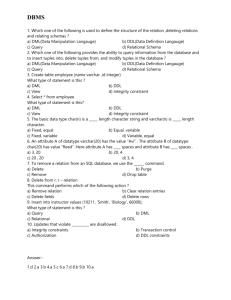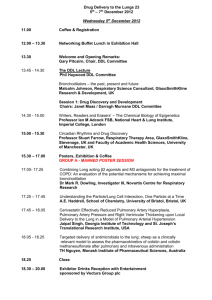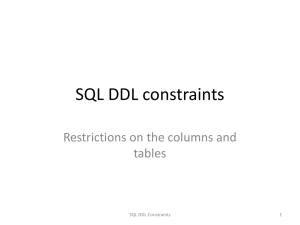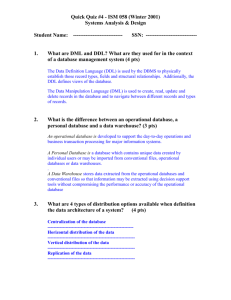Atlas Service Programmers' Manual
advertisement
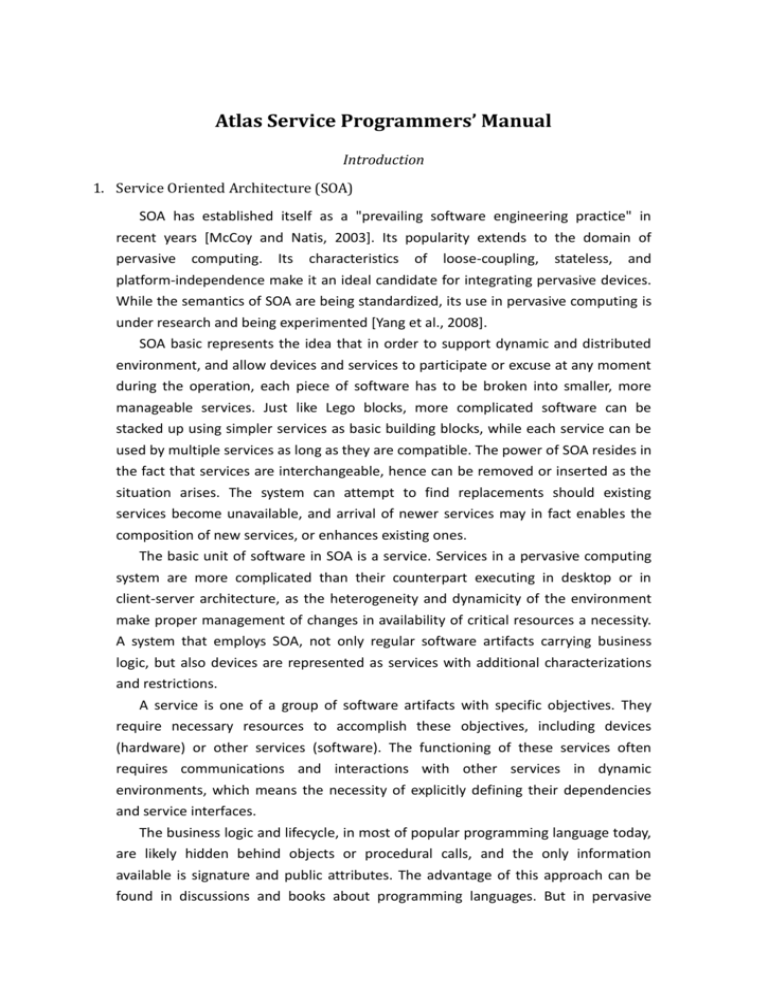
Atlas Service Programmers’ Manual Introduction 1. Service Oriented Architecture (SOA) SOA has established itself as a "prevailing software engineering practice" in recent years [McCoy and Natis, 2003]. Its popularity extends to the domain of pervasive computing. Its characteristics of loose-coupling, stateless, and platform-independence make it an ideal candidate for integrating pervasive devices. While the semantics of SOA are being standardized, its use in pervasive computing is under research and being experimented [Yang et al., 2008]. SOA basic represents the idea that in order to support dynamic and distributed environment, and allow devices and services to participate or excuse at any moment during the operation, each piece of software has to be broken into smaller, more manageable services. Just like Lego blocks, more complicated software can be stacked up using simpler services as basic building blocks, while each service can be used by multiple services as long as they are compatible. The power of SOA resides in the fact that services are interchangeable, hence can be removed or inserted as the situation arises. The system can attempt to find replacements should existing services become unavailable, and arrival of newer services may in fact enables the composition of new services, or enhances existing ones. The basic unit of software in SOA is a service. Services in a pervasive computing system are more complicated than their counterpart executing in desktop or in client-server architecture, as the heterogeneity and dynamicity of the environment make proper management of changes in availability of critical resources a necessity. A system that employs SOA, not only regular software artifacts carrying business logic, but also devices are represented as services with additional characterizations and restrictions. A service is one of a group of software artifacts with specific objectives. They require necessary resources to accomplish these objectives, including devices (hardware) or other services (software). The functioning of these services often requires communications and interactions with other services in dynamic environments, which means the necessity of explicitly defining their dependencies and service interfaces. The business logic and lifecycle, in most of popular programming language today, are likely hidden behind objects or procedural calls, and the only information available is signature and public attributes. The advantage of this approach can be found in discussions and books about programming languages. But in pervasive computing environments, it poses as both an advantage and a disadvantage, since dynamic compositions are common, and it allows any developer to plug in software artifacts as long as the interfaces are consistent, but makes no revelation or guarantee about the compatibility or correctness of the implementation. In most practical situations, it often relies on the implicit trust on the vendor or programmer to assume that the software artifact delivers the goals while avoiding the traps. 2. Atlas Architecture and OSGi The Atlas architecture is a framework for pervasive computing systems in the Mobile and Pervasive Computing Lab at the University of Florida, which provides a scalable network-enabled, service-oriented middleware in which numerous and heterogeneous sensors and actuators can be automatically represented as software services upon activation. It offers programmers with services and associated utilities to manage devices and compose applications without the detailed knowledge of the physical characteristics of the devices or the sensor platform node. The Atlas architecture, which includes both the middleware and the sensor platform as shown in Figure 1, provides an all-around solution to the development and deployment of pervasive computing systems. Figure 1 Atlas Architecture The middleware layer of the Atlas architecture has heavily utilizes the framework provided by OSGi. OSGi is the abbreviation of Open Service Gateway Initiative supported by OSGi Alliance, a non-profit group collaboration whose members include some of the biggest names in computing, appliance, and telecom industries, such as IBM, Sun Micro, Red Hat, Samsung, Hitachi, NEC, etc. OSGi aims to be the universal middleware. With great support in dynamic lifecycle management, this technology allows programmers to create service-oriented, component-based dynamic module system implemented in Java. It promotes high level of interoperability, and creates systems that are robust, and unflinching in dynamic environments. 3. Software Engineering Process of Service Implementation The process of designing and implementing a new service is summarized in a flowchart (Figure 2). 4. Basic Structure of Software within Atlas Architecture A service using Atlas architecture can be represented using the following three entities, service description, interfaces and software artifact(s) that actually provide the expected service. Sometimes the interfaces or knowledge associated with service description may be embedded within the code, but with the SOA approach, it is preferable to make them explicit to facilitate the dynamic interactions. For example, the reference implementation of OSGi platform suggests explicit definition of interfaces, places dependency related information in the manifest, and bundles them together with associated classes into a single bundle The typical software structure within the Atlas architecture include 3 Java classes/interfaces and a manifest file. 1. The interface presents the public methods that other services can invoke; 2. The activator class implements lifecycle management functionalities, so the service can be enabled, disabled and adapt properly; 3. The implementation class is where the service logic resides. The computation, communications and processing specific to the service is implemented in this class; The manifest file must be both human and machine readable. It includes all the basic generic information about the service, author, and support, as well as the specification of the java package dependency between services. In addition, as an integral part of the implementation, programmers also have to provide detailed information about the target service, such as supported methods, allowable parameters, operation conditions, supported protocols and in case of devices, hardware interfaces, etc, in a descriptor file, using the device description language (DDL). Start Design Include/Convert documented design spec Define service objectives Implementation Review design against service objectives spec Devise service logic Identify resource and dependency Implement service logic Verification/ Compilation Implement emergency handler Deployment Design software architecture Detailed design Implementation End Class Interface Service Logic Methods/Interfaces Manifest File Impl. Safety API Operational Service Descriptor File no yes Build File Impl. emergency handler Customization Misc. Info no yes yes Dynamic Info General Service Info Desc. File Verified no parameters Dependency/Resource Other Info yes Compilable no Figure 2 Flowchart for programming services 5. Atlas Programming Toolset The Atlas programming toolset is provided to assist programmers in implementing new services based on the Atlas architecture more efficiently and effectively. Two major authoring aides are included in the toolset, an integrated development environment (IDE) which allows programmers to devise more sophisticated services, and a service generator which can be used to automatic create service bundles from the semantic descriptions using device description language (DDL), particularly useful when dealing with more rigidly defined hardware device related services. Assistances and benefits offered by the IDE includes, Provides step-by-step guidance to design new service Enforce explicit specification of semantic knowledge on service/device and user during implementation Provide templates of various source code Hide the complexity of OSGi bundle programming and the interaction with safety mechanisms from programmers Verify existence of explicit descriptor files and Safety API before deployment Allow remote programming of intelligent environments Assistances and benefits offered by the service generator includes, To be provided by Chao. 6. How to Choose Which Tool to Use When Programming Services To be discussed with Chao. Summary of Device Description Language (DDL) 1. Overview DDL (Device Description Language) is an XML-based description language which is being developed to initially support the integration of devices such as sensors and actuators to the intelligent environments. However, the specification is being written with enough flexibility to accommodate actuators and more complicated devices such as blood pressure monitors. DDL enables a uniform schema to describe devices and defines a proposal to the Service Oriented Device Architecture (SODA) standard. The major goal of SODA is to represent devices such as sensors and actuators as services in today’s enterprise Service Oriented Architecture (SOA). With well-defined interfaces, software services are everything application developers need to know to bring together the devices and program the smart space. They should not worry about the nitty-gritty details of each ports and pins. However, the reality is that wiring and interfacing with devices of all types has been one of the major headaches of the real-world developer. This community needs a convenient solution that closes the gap between the physical devices and digital world. DDL provides a standard tool that describes a variety of devices in a common language that are readable to both human users and computer programs. It creates a common interface for sensors and actuators and enables automatic integration of these devices in the programmable smart space. This manual serves as a quick starting point for programmers who have no previous experience with DDL. For more detailed information of the language, the DDL Specification (version 1.2 available at http://www.icta.ufl.edu/atlas/*.*) consists of a complete documentation and several sample applications. Also available online is a DDL language processor (version 1.2 available at http://www.icta.ufl.edu/atlas/*.*) which is a piece of software capable of parsing and verifying DDL documents and creating service bundles that represent devices in the SOA framework. These documents and tools provide good resources for learning the DDL language. The remaining of this section is organized as following. Section 1.2 goes over the basic syntax and semantics of the language. Section 1.3 briefly explains the mechanisms of service oriented architecture and then provides a quick glimpse at some example applications of DDL. 2. Basic elements of DDL In DDL, a device is characterized as a physical (hardware) or logical (software service) entity consisting of a set of properties, some internal mechanism responsible for the operation of the device and interfaces to receive input from the device or send output to the device (Figure 1). From a service-oriented perspective, the characteristics of a device which are essential to its utilization by an external user are its properties and interface. The properties provide information about a device such as its purpose, its capabilities, vendor and operating requirements. The interface defines how a device interacts with its external users and provides ways to access the device either to get information from it and/or to control it. I External Output System t Input Internal n e Mechanism Properties r f a Figure 1. Characterizing c a Device e In DDL, devices are classified into three categories according to the difference in interfacing: Sensor, Actuator and Complex Device. Sensor: A sensor is a device which only provides input to the external user. Actuator: An actuator is a device which only accepts output from the external user. Complex Device: A complex device is one which can both accept output from the external user and provide input to the external user. The DDL specification provides a more detailed definition of these three categories and an example device of each category. In this manual, however, we mainly focus on sensors which are the most common and the easiest to describe. 2.1. Description of Sensors A DDL document of a sensor consists two parts: description and interface. Description provides name and model information of a device, as well as high-level function descriptions and deployment requirements to application developers and system integrators. The Description element includes tags such as Name, Device_type, Verbose_description, Vendor, Version and a composite element Physical which provides dimension and operating environment information for deployment. Figure2 gives an example of the Description element that describes the temperature sensor. <Description> <!-- Identification information of the device --> <Name> <!-- Name of the device --> Temperature Sensor </Name> <!-- Type of Device (Physical(Singleton) or Virtual) --> <Device_Type> Physical </Device_Type> <Verbose_Description> <!-- Description of the device --> TMP36 Analog Temperature Sensor </Verbose_Description> <Vendor> <!-- Device vendor --> University of Florida </Vendor> <Version> <!-- Device version --> 1.0 </Version> <Physical> <Dimensions> <!-- Dimensions of the device --> <Length> <!-- Length in mm (not available for virtual sensor) --> 24 </Length> <Width> <!-- Width in mm (not available for virtual sensor) --> 34 </Width> <Height> <!-- Height in mm (not available for virtual sensor) --> 24 </Height> </Dimensions> <Operating_environment> <!-- Permissible environment for operation --> <Temperature> <Range> <Min> </Min> <Max> </Max> </Range> </Temperature> <Humidity> <Range> <Min> </Min> <Max> </Max> </Range> </Humidity> </Operating_environment> </Physical> </Description> Figure 2. Example description of TMP36 analog temperature sensor 2.2. Interfaces From a data-oriented perspective, a device can be modeled as a process consisting of inputs, data processing and output. In a service-oriented architecture, each device has a service representation which provides access to its properties and interface and abstracts away its internal operation. Hence, in this document we describe the operation of devices in terms of input/processing/output from the perspective of their respective service objects (devices are said to be members of their respective service objects). In the description language described in this document, communication between member device(s) and their service object are called ‘Signals’ and outputs sent from the service object to an external user are called ‘Readings’. The Interface element in DDL is a collection of Signals and Readings that provide a way to define interactions between devices and applications. Figure 3 shows a fragment of a DDL document that describes the interface of an analog temperature sensor. The commented parts in gray color are explanations of each element and attributes. For more detailed information, learners should read the DDL specification and the DDL schema. <Signal id=”s1”> <!-- To avoid confusion, ensure Signal id is always alpha-numeric instead of numeric --> <Operation>Input</Operation> <!-- Value of Operation attribute can be Input or Output --> <Type>Analog</Type> <!-- A Signal Type can be: Analog or Digital or Protocol or Logical * Analog/Digital is a low level collection of pins * Protocol is a high level interface to a device which has an in-built communication protocol (example: AnD Blood Pressure Monitor) * Logical is high-level device service. --> <Measurement> <!-- Value of Measurement attribute can be: ADC, Digital or a string whose value is equal to the Reading->Measurement attribute of another physical/virtual sensor --> ADC </Measurement> <Unit>null</Unit> <Number> <!-- Number can be Single or Multiple (many signal inputs of same type) --> Single </Number> <Range> <Min>0</Min> <!-- write null or leave blank if you don’t know --> <Max>1023</Max> <!-- write null or leave blank if you don’t know --> </Range> </Signal> <Reading> <Type> <!-- Type can be: Basic(Virtual Sensor), Derived(Virtual Sensor), Physical (Singleton Sensor) --> Physical </Type> <Measurement>Temperature</Measurement> <Unit>Centigrade</Unit> <Computation> <Type> <!-- Possible value of the Type attribute can be: Aggregate, Formula or Map --> Formula </Type> <Expression> <!-- Possible valid Expression attribute values can be: * For Type=’Aggregate’: Mean, Median, Mode, Max, Min, Sum * For Type=’Formula’: <numerical expression as function of signal ids> * For Type=’Map’: <map of signal ids to range of output values> --> <!-- The formula function conforms to Java syntax --> reading = (((s1/1023)*3.3)-0.5)*(1000/10) </Expression> <Range> <Min> <!-- can be calculated automatically --> </Min> <Max> <!-- can be calculated automatically --> </Max> </Range> </Computation> </Reading> </Interface> Figure 3. Example interface of TMP36 analog temperature sensor Integrated Development Environment To assist programmers in implementing safer pervasive computing services based on OSGi, an authoring tool in the form of an integrated development environment is provided to the programmers. Eclipse is an IDE originally designed for Java programming. As it happens, OSGi platform and the service bundles are also designed to be implemented in Java. The decision to develop the IDE tool set as an Eclipse plug-in is therefore quite straightforward. But there are more reasons for this design decision, Eclipse is implemented to be completed platform-neutral, allowing developers to use Windows, Linux or any other operating systems which can run Java programs. Eclipse provides an open platform, allowing numerous third party plug-ins to integrated seamlessly with Eclipse, hence allowing its capability to be further enhanced as the synergy between the original functionalities and the installed plug-ins continues to grow. Choosing to implement the IDE tool set on top of Eclipse makes it possible to take advantage of all the available extensive capabilities, to allow programmers to use an IDE they are probably quite familiar to start with, hence make the task of programming safe and less error-prone OSGi services much less daunting for programmers. The implementation of this IDE consist of two parts, the front-end that allows programmers to intuitively and easily design the new services using the tools provided, and the back-end that actually offers these functionalities when activated from the front-end. As of today, the implementation of the Eclipse plug-in ver. 2.0 is almost completed with the back-end, and the design of the front-end is just underway. This document will focus on explaining the basic programming procedures as dictated by the implementation of the back-end. The programming process of a new service is organized into a six-step process: 1. Creation of a new project 2. Creation of semantic files 3. 4. 5. 6. Retrieval of dependent bundles and projects Generation of code template Compilation and verification Deployment into a runtime system We’ll succinctly explain these six steps as following: 1. Creation of a new project As with any other Java projects created using Eclipse, the plug-in create the new project and setup the necessary directories and file structures for a new project. What is different from ver. 1.0 of this plug-in is, ver. 2.0 does not automatically assume all other projects within the same workspace are part of the dependency requirement for the newly created OSGi service project. 2. Creation of semantic files As per discussion in the Appendix A of my dissertation, it is crucial that the semantic knowledge about the service, device and users are explicitly expressed so as to avoid misunderstanding and enhance the interoperability in highly dynamic environments. As part of the project creation process, important semantic description and project management files are created using templates. These files include a. .project file: which describes the attributes of a project b. .classpath file: which describes the classpath of all dependent resources at the time of compilation c. Manifest file: which annotates generic information and attributes about the bundle (to be filled by the programmer), as well as the package dependency d. Build file: which gives instruction on how and what to be compiled and build into the final service bundle e. Service descriptor file: which annotates detailed information about the services, such as the methods supported, parameters, service dependencies, user requirement alignments as well as emergency handler specifications f. Logging property file: which denotes the various set up of service logs, including level and location of what to be recorded 3. Retrieval of dependent bundles and projects Services built on SOA have dependencies. They require the existence of other services to support their proper functioning. Programmers can either specify these dependencies in the service descriptor file, but they can also use drag-and-drop operation from the front-end to include additional bundles and services as dependent entities. Either way, the back-end would attempt to retrieve these necessary bundles for the sake of proper compilations. 4. Generation of code template Instead of generating the entire code that includes every function, the design of the software structure is to place as much of the code associated with OSGi bundle related operations and safety mechanism invocations to base classes, hence maintaining a minimal and clean extended classes in the template when presenting to the service programmers. The ultimate objective is to allow programmers to implement services as easily and straightforward as regular java applications without having to worry about these additional mechanisms. The basic code structure in these generated code templates already includes separate methods for operations such as state transitions and emergency handler methods. Service programmers would only need to fill in the service logic in appropriate methods created as part of the templates. 5. Compilation and verification Prior to the compilation of the new service, the back-end performs a series of verification, such as the support of the Service Safety API, the provisioning of the emergency handler, and the conformance of semantic descriptions files to their respective schemas. Although the correctness of the actual logic implementations for these handlers cannot be tested without detailed knowledge about the service, the step of verification ensures that at least the programmers have provided some sort of procedures to be followed when the worst come to happen. After the implementation of the new service is verified, it is then compiled into a single service bundle in the form of a jar file. 6. Deployment into a runtime system With a single press of a button, the IDE can deploy the compiled service into an OSGi framework. Currently, the design of the front-end includes views for browsing available service bundles on any connected OSGi platform, the step-by-step guidance information panel, the toolbar for tracking and manipulating the stages of the six-step process, and all encompassed in a single OSGi service implementation perspective. The detailed design of the front-end is still evolving, and may change without further notice. Device Service Bundle Generator DDL is based on the concept that the availability of standard device descriptions allows for the development of intelligent environment applications integrating multiple sensors, actuators and complex devices. By representing each device as a service in the service-oriented architecture (SOA), programming the smart space becomes as easy as calling a number of methods from the device services. This subsection provides an example project that shows how DDL fits into the SOA framework and supports the programmable smart space. The example showcased in this section is an application that uses DDL language processor to automatically generate device drivers. In this example, the output of the application is a driver program, which is a software entity that represents the device in the SOA framework. It describes the functions and properties of the device and allows interfacing with the other services and applications in an Atlas-enabled software environment. At the client side, user checks in the DDL document for a certain device through the DDL web interface. The DDL document can be provided by the device manufacturer or generated by the web script as user fills in the necessary information in the HTML form. A DDL validity checker runs at the server side and examines uploaded information for syntax errors. The errors and warning information will show up on the webpage if there is any. If the errors are cleared, the DDL file generator will create a downloadable DDL file for the device. The DDL file device is then passed to the DDL parser and the driver generator. This software analyzes the DDL document and creates a driver project for the device. The project includes the source code for the driver program, build file and manifest information and is buildable using Apache Ant 1.7.0 or higher. Once the project file is prepared, they will be built automatically into the sensor driver software and uploaded to the sensor repository. The user or other programmers can use the device described by loading the device driver and integrated it in their applications. Figure 4 shows the process and data flow of the sample application described in this appendix. Figure 4. The flow chart for the DDL Sensor Driver Generator References [McCoy and Natis, 2003] McCoy, D. W. and Natis, Y. V. (2003). Service-Oriented Architecture: Mainstream Straight Ahead. Technical report, Gartner Inc. [Yang et al., 2008] Yang, H.I., Bose R., Helal, A., Xia J. and Chang, C. (2008). Fault-resilient Pervasive Service Composition, Book Chapter in "Advanced Intelligent Environments, Hagras, H., Eds., Springer Verlag. To appear 2008.
